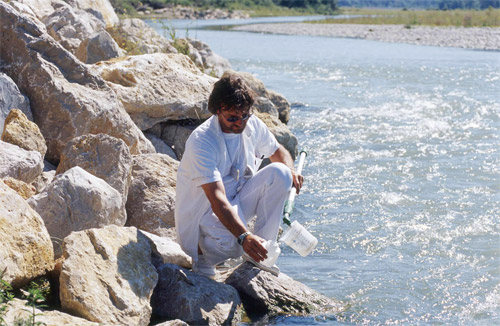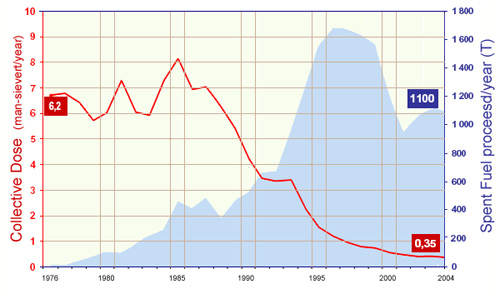Strict regulations for an efficient radioprotection
Radioprotection has a long history. Its principles can be traced back to 1928 when, following the discovery of some negative side effects of radiation, the International Committee for Protection against X-rays and radium – the ancestor of today ICRP – was founded.

Monitoring the environment
Water sampling from the Durance for testing near the Cadarache center, one of the most important facilities of the CEA, the French nuclear agency. Environmental checks in the vicinity of nuclear sites are under the responsabilities of agencies such as the CEA and of radioprotection services.
© T.Foulon /CEA-CADARACHE
Very few activities today are as closely scrutinized and heavily monitored as the use of radioactive sources and ionising rays. The rules surrounding radioprotection are in place around the world, laid down by organisations and committees of experts affiliated to either the European Union or the United Nations.
In general it is these organisations responsible for the safety of nuclear sites that take care of the necessary radioprotection. In France, the Nuclear Safety Authority (ASN) is charged with ensuring that the relevant radioprotection laws are respected, and the Institute for Radioprotection and Nuclear Safety (IRSN) uses its expertise to analyse risks, carry out measurements and conduct its own research in the field.
The role of such organizations is not only to avoid potential accidents and releases of radioactivity, but also to minimize the impact nuclear sites have on the environment. A heavy legal framework surrounds the control of waste products coming out of these facilities.
The legal limits in place for radioactive exposure have already brought benefits to specialist workers as well as to the ordinary citizen. In France, for instance, a nuclear power station produces a dose of 0.002 mSv per year – less than a thirtieth of a dental X-ray scan and under a thousandth of the natural levels of radioactivity.
In addition to the controls surrounding nuclear industry, there are numerous regulatory bodies that monitor the ionising rays emitted by various medical procedures. In 2007, the ASN conducted over 800 inspections in the 180 French radiotherapy centres, facilities which treat some 200,000 patients a year. The use of radioactive sources and ionizing rays is very strictly controlled.
Adding radioelements to comestibles or to construction materials is forbidden, particularly when it comes to foodstuffs, cosmetics or children’s toys. This strict regime does not cover naturally occurring radioelements, such as radiocarbon or potassium 40 present in milk. It would be impossible.

Reducing the collective dose at La Hague plant
The improved regulatory framework and the efforts made by the nuclear industry have spectacularly reduced the doses that nuclear workers are exposed to. At the La Hague reprocessing facility, for instance, the collective dose for all personnel went down from 6.2 man-sievert in 1976 to only 0.35 in 2004 while during the same period the annual output of the factory increased from 0 to more than 1000 tons.
© Areva/ R. Do Quang et P.Baron
In order to improve the estimated doses received by the population, a national survey of the environment was recently conducted in France. A surveillance network collects the results of these state-run tests, which are then handed over to either the IRSN or the ASN for analysis.
The management of radioactive waste outside of nuclear industry – especially waste produced by hospitals – is also very carefully regulated. Specific disposal sites are chosen for all short-lived radioelements, but those with half-lives longer than 100 days are kept under surveillance in the hospital. Iodine 131, commonly used in thyroid therapies, is an excellent example.
Learn more :
Other articles on the subject « Radioprotection »
Radioprotection principles
Applying common sense rules according to radiation nature The need for protection from radiation [...]
Gamma Radioprotection
A penetrative radiation more difficult to absorb In the case of ingestion of radioactive substanc[...]
Gamma Attenuation
Attenuation of a gamma beam Of the three types of radiations, gamma rays are the most penetrative[...]
Gamma Absorption
Heavy materials for the absorption of gamma rays In terms of radioprotection mitigate gamma rays [...]
Radioprotection neutrons
A rare radiation, dangerous, penetrating, difficult to absorb The neutron radiation is more penet[...]
Radioactive Decontamination
Avoid all contact, ingestion and inhalation One of the tasks of radiation protection is the decon[...]
Justification and optimisation
In medicine, use of radiation must be justified The ‘Justification and Optimization » princ[...]
Dose legal limits
Applying the precautionary principle and setting cautious limits French regulations set at 1 mSv [...]
Actors in radioprotection
The actors and the basics of radioprotection regulations The rules of radiation protection are no[...]